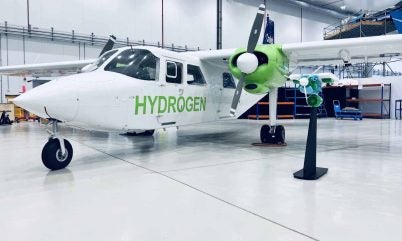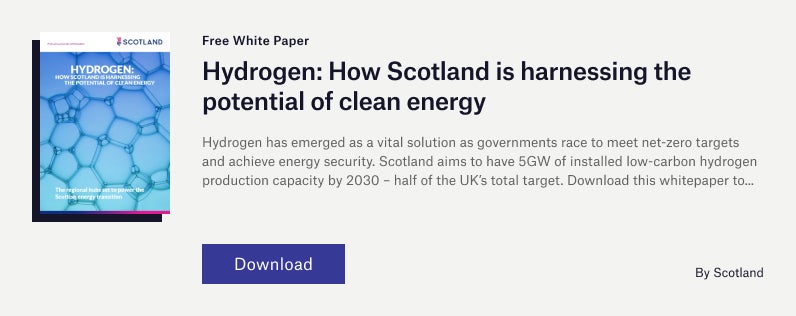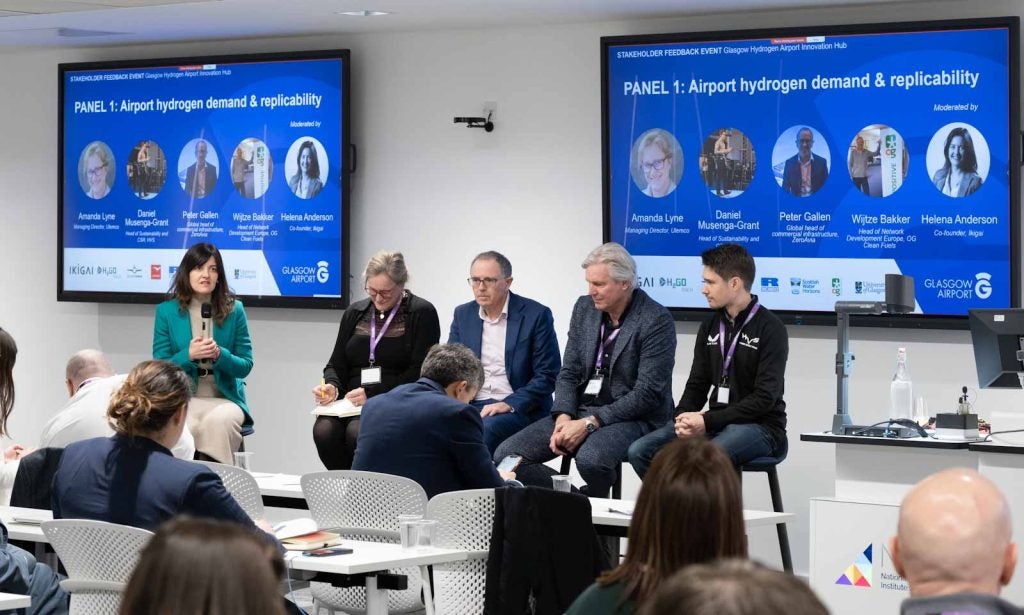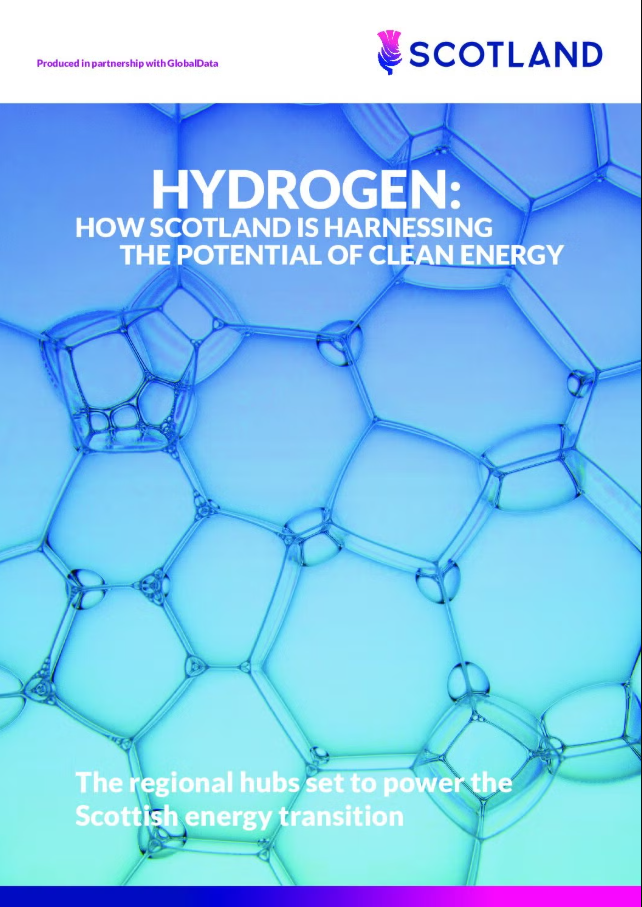
The aviation industry is turning to hydrogen as an essential solution to aid the decarbonisation drive. To deliver on this ambition and harness the potential of clean fuel in aviation, Scotland has a series of initiatives aiming to prove the viability of zero-emission flight and build vital infrastructure.
According to various estimates, the aviation sector is responsible for up to 3% of all carbon emissions globally. To address this impact, hydrogen aircraft are expected to become an increasingly common sight in the skies over the next two decades and beyond.

By 2040, the International Air Transport Association predicts hydrogen aircraft will account for the majority of those used for commercial short-haul flights. As soon as 2035, an estimated 50–100 commercial aircraft could be running on hydrogen for flights lasting 90 minutes.
Furthermore, this aligns with Scottish hydrogen ambitions. Scotland plans to have a hydrogen production capacity of 5GW from zero-emission or low-carbon methods by 2030. These production capacity ambitions increase to 25GW by 2045 – when Scotland also has a legal mandate to reach net zero.
To make these necessary advances for aviation, numerous challenges must be overcome – and significant progress is being made in Scotland to get there.
The importance of SAFs in decarbonising air travel
It can take 30 years to update an entire aircraft or shipping fleet. The development time alone to bring a new aircraft to the market typically takes at least a decade from initial design to manufacturing.
In addition, using pure hydrogen as a fuel requires completely new infrastructure for the production of gaseous or liquid hydrogen. This also requires updated logistics and storage capabilities at ports and airports. In the meantime, sustainable aviation fuels (SAFs) or synthetic fuels are considered a viable solution to decarbonise the kerosene used by planes. These can be used by existing aircraft without any major updates to infrastructure or engines.
SAFs will be particularly important for reducing emissions from long-haul aircraft, which are more challenging to decarbonise than smaller planes operating on shorter routes.
By 2030, the UK Government has mandated that 10% of SAF will be used for all aircraft fuels nationally – which is approximately 12 million tonnes of fuel that doesn’t currently exist.
To address this issue, Scottish Enterprise published a mapping report on SAFs in 2023 in collaboration with Optimat. The report proposed viable solutions for the pathway to decarbonisation and the scale of the challenge. At present, SAF accounts for just 0.01% of the global market. Over the next four years, it is predicted this figure will rise to 7.6% amid an increase in market demand. Therefore, there is both a production gap and a market opportunity.
“It is huge,” says Jon Simpson, sustainable fuels lead at Scottish Enterprise. “You are talking about a 1,600-times scale-up required in synthetic fuel for aviation alone.”
While airports and shipping ports making efforts to switch to renewables to power more operations and assets on site, reducing Scope 3 emissions beyond their control is a considerable challenge.
“When it comes to Scope 3 emissions, the only things that airports and ship operators can do right now is change the fuel,” adds Simpson.
Scotland has considerable advantages in contributing to demand for SAFs. Along with the growing renewable capacity to produce clean or low-carbon hydrogen, there are also advances in carbon capture utilisation and storage (CCUS) that will help cut emissions from industrial processes. Captured carbon dioxide also provides supplies of carbon that can be blended in SAFs to create ‘drop-in’ fuels. Then there are the strengths Scotland has in the supply chain for SAFs, with opportunities for many Scottish companies.
Developing a hydrogen aviation hub
Hydrogen may emit zero emissions at the point of use, but its standard production method is carbon-heavy. However, an electrolyser powered by renewables that divides water into its chemical elements is a proven method of green hydrogen production. Using carbon capture in traditional hydrogen production processes offers a further means to build supplies of this essential fuel and reduce the environmental impact.
Lack of infrastructure is a major challenge to establishing the hydrogen economy, a challenge that is being addressed in Scotland with the development of 13 dedicated hydrogen hubs around the country.
For aviation specifically, a hydrogen production, storage and distribution hub is being planned at Glasgow Airport. With partnerships vital to such projects, considerable efforts have been made to bring together partners from industry, government and academia.
What makes Glasgow Airport an optimum location for a hydrogen hub is that it is multi-modal in terms of vehicle use. The intention is for hydrogen produced at the site to serve virtually all modes of transport in the aviation sector, not just the aircraft but also ground-handling vehicles and buses on the runway, as well as visiting coaches, HGVs and delivery vans. Back-to-base users will help build the essential refuelling structure at a key location on regular routes that are easily accessible, as well as deliver supply security.
Initially, the focus will be on producing gaseous hydrogen from a solar farm on-site to power an electrolyser, with additional power from the grid. By 2025, the plan is to produce hydrogen on-site from the 7.5MW solar farm. By 2030, the solar farm capacity will rise to a maximum of 20MW. A total of 8.5MW will come from the grid, which will remain consistent throughout the three phases of the project.
“Our ambition on this project was to focus on on-site generation, because it enables us to avoid certain costs that bring the price of the power down and [that] means the price of hydrogen comes down,” says Helena Anderson, co-founder and chief operating officer at Ikigai Capital, which provides support and advice for the decarbonisation of challenging sectors.
Ikigai Capital has been a leading partner on the comprehensive feasibility study of the Glasgow Airport project, working alongside other industry partners such as AGS Group.

Building hydrogen infrastructure at Glasgow Airport
The hydrogen hub plans for Glasgow Airport are intended to be standardised so that they can be replicated anywhere in the world.
There is confidence that Phase One and Two of the Glasgow project can get hydrogen production costs below £10 per kilogram (kg). In fact, predictions from those involved in the project suggest that the site could eventually produce hydrogen at costs of £4.16/kg in a best-case scenario, making it competitive with other fuel sources.
The initial plan for the project is to focus on the production and storage of gaseous hydrogen rather than liquid hydrogen. In the longer term, there is a consensus that liquid hydrogen will be used by larger aircraft. Here, the hydrogen hubs being developed around Scotland will be crucial for supplies.
“Everything above 20-seater [planes] is absolutely going to go liquid one day and even the smaller planes may go liquid eventually. But that is why our project is focused on initially gaseous to serve the planes that can demonstrate it with a view to then switching the demand for that production on-site to other applications,” adds Anderson. “To focus then on trucks [and] buses so that you have a security of supply solution for critical loads such as the aeroplanes if you need it.
“But it is not realistic with the cost structure associated with liquefaction of hydrogen for every single airport to have their own liquefaction facility on site,” she adds. “That is where we look to the Scottish Government to have shared infrastructure facilities for liquid hydrogen.
“You have to start somewhere and gaseous is the easiest way for an individual airport to make a move on hydrogen and look at all the infrastructure that needs to surround it to make it viable, and then future-proof it for the long term.”
Having hydrogen refuelling infrastructure at Glasgow Airport will give airlines operating from the site the confidence to purchase new aircraft that run on zero-emission fuel.
“That whole chicken and egg thing, we are trying to break that by choosing an airport that is so well-equipped and so visionary that it is able to take that step before others – with the support from the Scottish Government,” adds Anderson.
Testing hydrogen aircraft in Scotland
Ever since the Wright brothers took their first flights more than 100 years ago, the principles of aviation development have been to start small and prove concepts before scaling up. Hydrogen aircraft are likely to follow this pattern.
Some flights on Scottish airline Loganair’s Islander services last for as little as two minutes, with the longest only lasting for 15 minutes. This makes the service ideal to test hydrogen-powered aircraft in challenging marine conditions, gain vital data and apply this to develop the technology further.
Loganair is currently working with Cranfield Aerospace Solutions to develop hydrogen-electric aircraft for the Islander flights. In addition, the partners are fitting a new hydrogen-electric propulsion system to the Britten-Norman Islander aircraft, which typically seats nine passengers. The plan is to have commercial and carbon-free flights running from Kirkwall in the Orkney Islands by 2027.
“These air services are embedded into the social fabric of these communities,” says Andy Smith, head of sustainability strategy at Loganair. “This is actually fundamental to people being able to live and work in remote parts of Scotland. Then, on the other side of it, you have Scotland PLC, as I like to think of it, with its vast wealth of experience in offshore oil & gas [and a] supply chain that supports that. It is all perfectly positioned to pivot to a cleaner alternative to fossil fuels.”
Loganair also operates services out of Glasgow Airport, which will put it in a strong position to take advantage of the planned facilities when hydrogen is adopted by larger aircraft. The airline plans to have a zero-emissions fleet by 2040.
“The quicker we can show how it works and improve the knowledge and the process, the quicker and more efficiently you will scale up and have a bigger impact,” adds Smith.
How hydrogen could change the way aircraft look
With liquid hydrogen widely predicted to be the future of aviation fuel, the aircraft of the future could look noticeably different. The designs of long-haul aircraft will need to change to accommodate the large hydrogen tanks on board.
The tube-body model passenger planes that have dominated skies for decades could be replaced by chunkier V-shaped, blended-wing aircraft.
“The blended wing body has been recognised as being a really efficient design, but there has never been enough justification to move away – with all the significant production and certification costs – from the classic wing and tube,” says Smith. “Instead, we have looked to improve that design.
“Retrofitting an existing aircraft design that was designed around conventional fossil fuel to take hydrogen is quite a compromise because that extra mass and volume of the tanks weren’t considered at the initial design stage. That creates an opportunity for a clean sheet design, incorporating hydrogen to deliver significant improvements even if the efficiency of the propulsion system is exactly the same.”
With these new planes, new infrastructure and skills will be required to service and refuel them. This provides opportunities for thousands of future jobs in Scotland that will continue the progress to decarbonise aviation in the country and beyond.
To learn more about the Scottish hydrogen hubs in development, download the specially commissioned document below.



